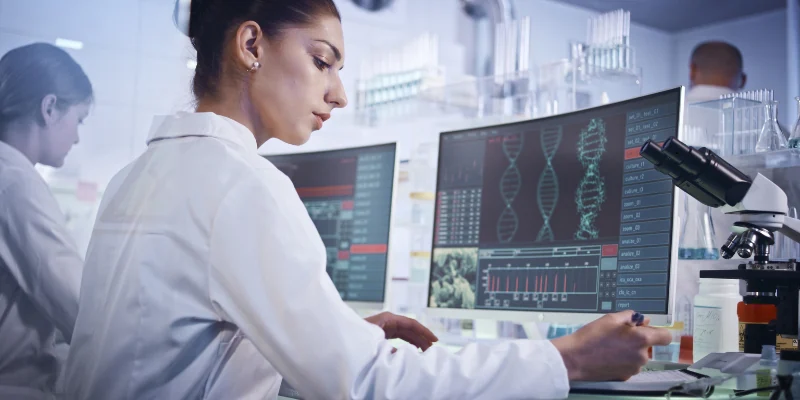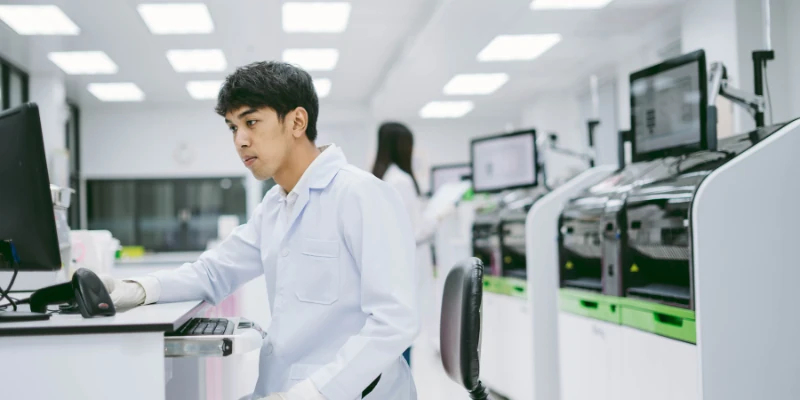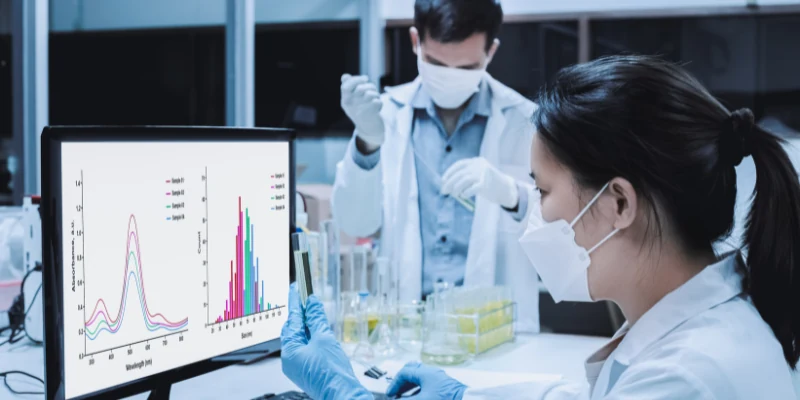Pros of computer in Scientific research: Interesting topic
Updated: 27 Dec 2024
34
Computers have transformed the world of scientific research, offering a multitude of benefits that have significantly transformed how research is conducted, analyzed, and shared. The start of computers has provided researchers with powerful tools to handle complex data, simulate experiments, and communicate findings across the globe. Below are the top 8 advantages of computers in scientific research, with an in-depth explanation of how each one has contributed to advancements in these fields.
1. Data Processing and Analysis
One of the most important advantages of computer in scientific research is their ability to process and analyze vast amounts of data quickly and accurately. In many scientific fields, researchers deal with huge datasets that would be practically impossible to process manually. Computers enable researchers to store, organize, and manipulate data with ease, allowing them to focus on analysis and explanation rather than data entry and management.
Example: In genomics, scientists work with genomic sequencing data, which involves millions of DNA base pairs. Without powerful computing systems, processing such large amounts of data would be a difficult task. Computers allow for the quick alignment of sequences, identification of genetic variations, and the extraction of meaningful patterns that can be used to understand diseases and genetic traits.
Statistical Analysis: Computer software tools, such as SPSS, R, and MATLAB, have made statistical analysis more efficient. These tools enable scientists to perform complex mathematical computations, model relationships between variables, and visualize data trends. This automation of data analysis helps researchers make data-driven decisions, which is vital in fields such as physics, economics, and epidemiology.

2. Simulations and Modeling
Simulations and modeling have become crucial in scientific research, and computers have made these tools more accessible and powerful. Researchers can now simulate complex systems or processes that would be difficult or impossible to study in the real world. Computers allow scientists to create models of physical, biological, or chemical systems, simulate various conditions, and predict outcomes.
Example: In climate science, researchers use computer models to simulate climate patterns and predict future changes based on various greenhouse gas emission scenarios. These simulations require significant computational power and provide valuable insights into the potential effects of climate change, guiding policy decisions and environmental protection efforts.
Fluid Dynamics and Engineering: In engineering and physics, computer simulations are widely used to model fluid dynamics, mechanical systems, and aerodynamics. For example, computational fluid dynamics (CFD) allows researchers to model airflow over aircraft wings or simulate how fluids move through pipelines. These models help improve designs, optimize performance, and reduce the need for costly physical prototypes.

3. Automation of Repetitive Tasks
In scientific research, many tasks are repetitive and time-consuming. Computers have enabled the automation of these tasks, significantly improving efficiency. Tasks such as data collection, experiment monitoring, and even complex computations can be automated using custom scripts or specialized software.
Example: In laboratory settings, researchers often need to run a series of experiments that require the same procedures to be repeated numerous times. Automation systems can control equipment, adjust parameters, record results, and provide real-time analysis without the need for constant human intervention. This not only saves time but also minimizes human error.
High-Throughput Screening: In pharmaceutical research, computers are used to automate the high-throughput screening of drug compounds. Instead of manually testing thousands of compounds, automated systems can rapidly test and evaluate their effectiveness, saving considerable time in the drug discovery process.
4. Collaboration and Communication
Computers have greatly enhanced collaboration in the scientific community, breaking down geographical and institutional barriers. Researchers can now collaborate in real time, share data instantly, and communicate via email, video conferencing, or collaborative platforms. The ability to share findings with colleagues, institutions, and even the public has accelerated the pace of scientific progress.
Example: The Human Genome Project, an international research initiative to map all the genes in the human genome, was made possible through global collaboration enabled by computers. Scientists from different countries could share sequencing data, work on the same computational models, and collectively contribute to the research despite being separated by vast distances.
Open Access and Databases: Computers have made it easier to store and share scientific data through open-access repositories and digital databases. Researchers can access data from across the globe, which fosters collaboration and accelerates innovation. For instance, public databases like PubMed, and GenBank allow scientists to access published research, datasets, and genetic sequences, contributing to the growth of scientific knowledge.
5. Visualization of Data and Results
Understanding and interpreting complex scientific data can be challenging. Computers allow researchers to visualize data through graphs, charts, 3D models, and other visual tools. These visual representations help scientists identify patterns, trends, and anomalies in data that might not be immediately obvious in raw form.
Example: In medical imaging, computers play a crucial role in visualizing and analyzing images from CT scans, MRIs, and X-rays. Software tools can highlight areas of concern, such as tumors or fractures, enabling quicker diagnosis and more accurate treatment planning. In neuroscience, researchers use brain imaging techniques like fMRI and computer software to create detailed 3D maps of brain activity.
Data-Driven Decision Making: In various scientific disciplines, from finance to engineering, visualizing large datasets can reveal trends that inform decision-making. Computer-based visualizations allow scientists to create interactive graphs, heatmaps, and scatter plots to explore relationships between variables. This capability is crucial in areas such as epidemiology, where it can help track disease outbreaks and understand their spread.

6. Speed and Efficiency
The computational power of modern computers has drastically reduced the time required for scientific research. Researchers no longer have to wait for extended periods to complete calculations or analyze data manually. Computers provide results in a fraction of the time, allowing scientists to test hypotheses more rapidly and iterate on their experiments more efficiently.
Example: In molecular biology, the process of aligning DNA sequences and identifying mutations, which once took weeks or months, can now be completed in hours or even minutes using modern computational tools. This rapid analysis accelerates the pace of research and enables scientists to make timely discoveries, particularly in fast-moving fields like genomics or epidemiology.
Faster Prototyping: In engineering and technology research, computer-aided design (CAD) software allows researchers to create virtual prototypes of products or machines. These prototypes can be tested and modified in a digital environment, saving both time and money compared to physical prototype testing. Engineers can experiment with thousands of design variations before committing to a physical model.
7. Improved Accuracy and Precision
Computers significantly improve the accuracy and precision of scientific research. Human error, which can occur in manual calculations or data collection, is minimized with automated systems. Additionally, computers enable the use of advanced algorithms that can process data with a high degree of accuracy.
Example: In particle physics, researchers use sophisticated computers to track and analyze the behavior of subatomic particles in experiments conducted at facilities like the Large Hadron Collider. These experiments involve an overwhelming amount of data, which can be processed with great precision using powerful computer systems, ultimately leading to breakthroughs like the discovery of the Higgs boson.
Reduction of Measurement Errors: In scientific instruments such as spectrometers, thermometers, and microscopes, computers play a vital role in minimizing measurement errors. Automated calibration, data recording, and analysis help ensure that measurements are precise and consistent, leading to more reliable and reproducible results.

8. Access to Vast Scientific Knowledge
With the help of computers, researchers now have access to a vast array of scientific knowledge that can be utilized in their own research. Online databases, scientific journals, and other digital resources provide researchers with the most up-to-date information, reducing the time spent on literature reviews and helping them stay informed about the latest developments in their field.
Example: Platforms like Google Scholar, ResearchGate, and JSTOR have made it possible for scientists to easily access peer-reviewed papers, technical reports, and other research materials. This access helps researchers build upon existing knowledge, identify gaps in research, and ensure that their work is aligned with current scientific thinking.
Literature Review and Citation Tools: Computers also help researchers with the process of literature review by providing advanced search capabilities that allow them to find specific papers or datasets related to their topic. Citation management software like EndNote and Zotero helps researchers organize references, format citations, and manage bibliographies efficiently.
What is computer science research?
Computer science research involves studying algorithms, systems, and computational processes to solve complex problems. It explores areas like artificial intelligence, data structures, cybersecurity, and software engineering. The goal is to advance technology and improve how computers are used to solve real-world challenges.
What are the uses of computer in science and research?
Computers enable scientists to process large data sets quickly, perform complex simulations, and model experiments. They facilitate collaboration through digital communication and cloud storage. Additionally, computers support advanced research tools like AI, machine learning, and computational biology, accelerating discoveries.
What is the basic concept of a computer?
The basic concept of a computer is a machine designed to process, store, and retrieve data. It operates through a combination of hardware and software to execute tasks based on user input or predefined instructions. Computers can perform complex calculations and automate processes, enhancing productivity and problem-solving.
What are the five functions of a computer?
The five main functions of a computer are:
- Input: Receiving data from external devices (e.g., keyboard, mouse).
- Processing: Performing calculations or operations on the input data.
- Storage: Saving data for later use (e.g., hard drive, SSD).
- Output: Delivering processed data to external devices (e.g., monitor, printer).
- Control: Coordinating and managing the flow of data and instructions within the computer system.
What is the role of research in computer science?
Research in computer science drives innovation by developing new algorithms, technologies, and methodologies. It addresses complex problems in fields like AI, cybersecurity, and software engineering, pushing the boundaries of what computers can achieve. This research is crucial for improving systems, enhancing performance, and shaping the future of technology.
Conclusion
Computers have become indispensable tools in the field of scientific research, offering a wide range of benefits that have transformed how research is conducted. From processing vast amounts of data to enabling complex simulations and fostering collaboration, computers have improved the efficiency, accuracy, and speed of scientific discovery. These advantages have not only transformed individual research processes but have also accelerated advancements in science and technology, paving the way for new discoveries and innovations that benefit society as a whole.
The continued development of computer technology promises to further enhance these advantages, allowing for even more sophisticated research tools and systems. As science and research become increasingly data-driven, the role of computers will only grow, opening up new possibilities and opportunities for researchers in every field.
Please Write Your Comments